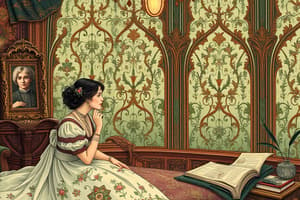Podcast
Questions and Answers
What is the term for the main character in a narrative?
What is the term for the main character in a narrative?
- Antagonist
- Narrator
- Supporting character
- Protagonist (correct)
Protagonists and antagonists always represent the same values.
Protagonists and antagonists always represent the same values.
False (B)
What role does setting play in a narrative?
What role does setting play in a narrative?
It establishes mood and atmosphere and provides information about characters.
________ refers to the physical and emotional distance of the narrator to the events of the narrative.
________ refers to the physical and emotional distance of the narrator to the events of the narrative.
What explains the conflicts that arise among characters in a narrative?
What explains the conflicts that arise among characters in a narrative?
Stream of consciousness narration describes a character's thoughts through continuous dialogue.
Stream of consciousness narration describes a character's thoughts through continuous dialogue.
What are archetypes in dramatic situations?
What are archetypes in dramatic situations?
Match the following terms with their descriptions:
Match the following terms with their descriptions:
Flashcards
Character Agency
Character Agency
The ability of a character to make choices and take actions, revealing their values and motivations.
Protagonist vs. Antagonist
Protagonist vs. Antagonist
The protagonist is the main character, often facing opposition from the antagonist, who can be another character, internal conflict, societal forces, or nature.
Contrasting Values
Contrasting Values
The protagonist and antagonist often represent opposing value systems, leading to conflict.
Setting's Influence
Setting's Influence
Signup and view all the flashcards
Dramatic Archetypes
Dramatic Archetypes
Signup and view all the flashcards
Contrast and Emphasis
Contrast and Emphasis
Signup and view all the flashcards
Narrator as a Character
Narrator as a Character
Signup and view all the flashcards
Narrative Distance
Narrative Distance
Signup and view all the flashcards
Study Notes
Unit 4: Nuance and Complexity
- This unit investigates the nuances and complexities of stories. It focuses on developing skills in analyzing sophisticated texts.
Character
- Character's importance is often revealed by their actions, choices and descriptions.
- Character's agency (actions and choices) reveal their values.
- Protagonist is the main character, while the antagonist opposes them. An antagonist can be another character, internal conflict, or a societal force.
- Protagonist and antagonist may represent contrasting values.
- Conflicts among characters arise from different values.
Setting
- Setting creates a mood and atmosphere.
- Environments reveal character traits.
Plot
- Certain plot patterns (archetypes) create expectations.
- Contrasts in characters, settings and values highlight essential plot elements.
Narrator
- Narrators may be characters, directly addressing the reader.
- Narrative distance describes the narrator's involvement or detachment from story events.
- Stream of consciousness reveals the character's thoughts directly.
- Narrators' or characters' perspectives shape the story's tone.
- Descriptive language creates perspective and tone.
Studying That Suits You
Use AI to generate personalized quizzes and flashcards to suit your learning preferences.





